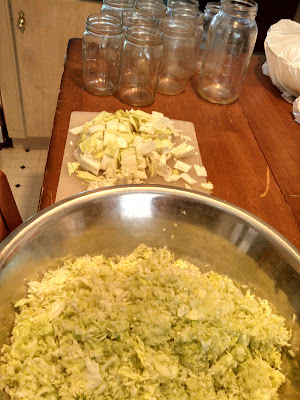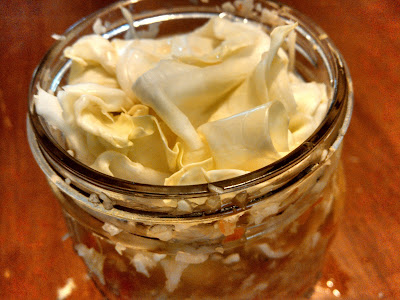 |
| To start a good sauerkraut, you will need cabbage. Peel off the outer leaves, wash them and set them aside for later. Cut the cabbage up until it is a size that will fit in your food processor chute. (If you don't have a food processor just start slivering slices of cabbage and then chop it until fine.) |
 |
When you have finished slivering it or sending it through the processor, put it in the largest bowl you have. These large stainless steel bowls work great. You need a big one to fit all of the cabbage at once. (For this, many other home cooking projects and that huge bowl of popcorn for party night!)
|
 |
| I run the cabbage one head at a time through my food processor and then dump it into the bowl. I like to use 4 or 5 heads of cabbage to make a bunch of sauerkraut. I love doing things in bulk to save time in the long run. (Check out my Whole Foods Binder recipes in the background - Ha Ha!) |
 |
| When you have all of the cabbage shredded you can shred other veggies to add to it if you want. This time I added some shredded carrots. You can add kale, a small amount of garlic, cucumbers, or beets. Even green apples can be yummy in it but beware that onions are to pungent to use this way. Stir all of the veggies together and sprinkle it with salt. You will know you have the right amount when your vegetables taste salted but not overpoweringly so. |
 |
| Now you can start packing your vegetable mix into the jars. Put about an inch at a time into the jar and press down with your fist or another object. Doing this step one inch at a time helps to get the juices flowing from the cabbage and for a brine to start forming. When your jar is a couple inches from being full, stuff a leaf or two of the cabbage that was set aside earlier onto the mixture. This does a couple of things. It keeps the kraut under the brine so it can ferment and it keeps air from reaching the kraut. |
 |
| I love how the jars start to look at this point. :) When you have your jars filled and there is a good brine forming, put lids loosely on the jars. You want the lids loose so the gasses can escape the jars. Clean the jars off and put them in an out of the way place. You will want to check on them periodically to make sure the brine is still covering the sauerkraut. If you need to add moisture, make a brine of 2 cups water and a Tablespoon of water and add it to the jar as needed. |
 |
| When you have let your jars sit out for 4-7 days, you can tighten the lids and transfer them to the fridge where they will last for months. I have let mine ferment on the counter for 4 weeks with great results and then put it in the fridge. I am not a licensed professional explaining these processes to you so if you have doubts or questions please research it a little further for your own health and safety. I have been doing this for several years now with no ill side effects but please use common sense and education to ensure your own success. I like to have some with every meal to give my body the digesting enzymes and probiotics I need. I also use kefir for this which I will explain another day. |
|
If you liked this information, you may enjoy these other sources on fermenting foods.
I once had the pleasure of being taught how to ferment vegetables for a couple of days by a true Japanese woman. She would slice vegetables very thin, usually bok choy, carrots, and cucumbers though I am sure the options are vast, and she would sprinkle salt between the layers of vegetables as she added them to her cool vegetable press. The press would then be turned so there was pressure holding the vegetables down and the brine would rise up above them. She actually gave me a press and I used it a ton. The vegetables can be added to stirfry's for awesome flavor or as a side dish.






